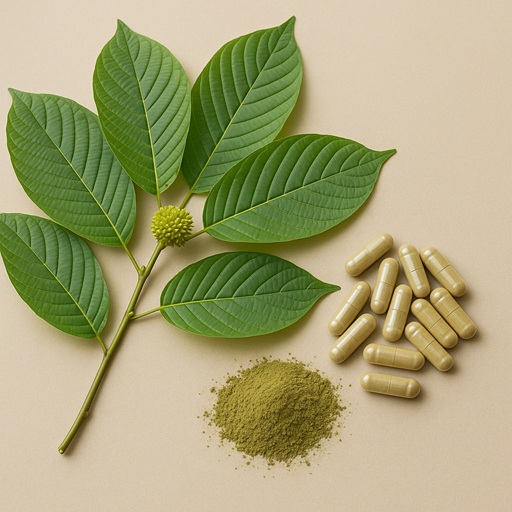Summary
Kratom is not classified as an opioid, but it acts on the same brain receptors as opioids. Its main alkaloids mitragynine and 7-hydroxymitragynine are partial μ-opioid receptor agonists, which means kratom can produce pain relief and mild euphoria similar to opioids but usually with less risk of respiratory depression. However, kratom can still cause dependence, withdrawal, and health risks. Scientists describe it as an “atypical opioid” because it has opioid-like activity without being a traditional opioid drug.
Introduction
Kratom (Mitragyna speciosa) is a tropical evergreen tree in the coffee family, native to Southeast Asia. Its glossy green leaves have been used for centuries as traditional medicine in countries like Thailand and Malaysia. Locally known as ketum or biak-biak, kratom leaves were traditionally brewed as a tea to relieve fatigue and pain, and to treat ailments such as diarrhea and hypertension. In recent decades kratom use has spread globally; in the United States, surveys estimate that 1–5 million people have used kratom. Much of this attention stems from claims that kratom can substitute for opioids in pain management or addiction treatment, leading to debate over whether kratom is an opioid.
Pharmacology and Mechanism of Action
Kratom leaves contain a complex mix of biologically active alkaloids. The primary compound is mitragynine, and its minor metabolite 7-hydroxymitragynine (7-OH) often contributes strongly to its effects. These alkaloids bind to opioid receptors in the brain. They function as partial agonists at μ-opioid receptors and as competitive antagonists at κ- and δ-opioid receptors. Critically, mitragynine and 7-OH are G-protein-biased agonists: they trigger G-protein signaling without recruiting β-arrestin (a pathway associated with many opioid side effects). In addition to opioid receptor activity, kratom alkaloids modulate other systems (serotonin, dopamine, norepinephrine), making kratom pharmacologically atypical compared to classical opioids. This mixed mechanism may underlie reported differences in effects, such as relatively less respiratory depression compared to full opioid agonists.
Effects and Dependence Potential
Kratom produces dose-dependent stimulant and opioid-like effects. Users typically report increased energy, alertness, and talkativeness at low to moderate doses, whereas higher doses produce sedation, analgesia, and euphoria similar to classical opioids. Animal and in vitro studies confirm analgesic activity: mitragynine-containing extracts reduce pain in rodent models in a manner reversible by naloxone (an opioid antagonist). Notably, kratom’s alkaloids appear to cause relatively less respiratory depression or severe sedation than full opioid agonists, likely reflecting their partial-agonist, G-protein–biased activity.
Kratom can induce dependence with regular use, but its withdrawal profile tends to be milder than that of heroin or prescription opioids. Surveys and clinical reports indicate that some chronic users develop cravings, tolerance, and withdrawal (e.g., anxiety, muscle aches) when stopping kratom. However, most cases of kratom use disorder reported in surveys are of mild severity, primarily reflecting physical dependence rather than compulsive abuse. Interestingly, animal studies show that mitragynine can attenuate opioid withdrawal symptoms, and some users self-medicate with kratom to ease opioid withdrawal. Nonetheless, kratom’s potential for addiction means it can be misused, and the FDA warns that kratom use can meet criteria for a substance use disorder.
Safety and Adverse Effects of Kratom
Kratom side effects are numerous and come with complications and in extreme circumstances, fatality.
- Serious toxicity: Kratom can cause liver injury and seizures among other severe adverse events. Although kratom overdoses are rare, a few deaths have been reported (nearly always involving other drugs), and any kratom-related fatality is cause for concern.
- Cardiovascular and neurological effects: High doses of kratom have been associated with tachycardia, hypertension or hypotension, dizziness, and tremor. Agitation, confusion, and even acute psychotic symptoms or seizures can occur, especially in overdose or with adulterated products.
- Dependence and withdrawal: Chronic use may lead to tolerance and physical dependence, with withdrawal symptoms such as anxiety, muscle cramps, and insomnia when use stops.
- Contamination risk: Because kratom is unregulated, products can be contaminated or adulterated. Authorities have detected heavy metals (e.g., lead, nickel) and Salmonella in some kratom batches. Some seized kratom has also been found to contain added synthetic cannabinoids or opioids.
- Special populations: Kratom use during pregnancy has led to neonatal abstinence syndrome in infants, underscoring the need for caution.
Legal Status (U.S. and Global)
Today most people still ask the important question; is kratom legal in the United States? Kratom’s legal status varies widely. In the United States it is not scheduled under federal law (the plant and its leaf extracts are not classified as controlled substances). In 2016 the DEA briefly moved to place kratom’s main alkaloids in Schedule I, but withdrew that proposal amid public and congressional opposition. Today, no kratom-based drug products are FDA-approved, and kratom is illegal to market as a dietary supplement or food. Some U.S. states have banned kratom outright (e.g., Alabama, Arkansas, Florida, Indiana, Tennessee, Wisconsin). The FDA has signaled intent to control certain pure kratom alkaloids (7-hydroxymitragynine) under the Controlled Substances Act, but the plant itself remains legal at the federal level.
Internationally, kratom is controlled in many countries but legal in others. For example, Malaysia, Singapore, and several European nations have banned kratom. Thailand recently decriminalized it after decades of prohibition, while Indonesia continues to regulate its production and export. Kratom’s legal status is complex and evolving, reflecting divergent views on its risks and benefits.
Policy and Public Health Considerations
Kratom’s growing use has raised debates among clinicians, researchers, and regulators. U.S. federal and academic voices are divided: some authorities (e.g., FDA) emphasize kratom’s risks and advise against its use, while others note the lack of approved opioid alternatives and suggest kratom could have a role in pain or addiction management. Advocacy groups and many users argue that kratom is a safer substitute for stronger opioids and can alleviate withdrawal, whereas public health officials caution that legalization without oversight could facilitate abuse. This tension has led to policy proposals ranging from outright bans to regulated access. For example, some U.S. states have implemented kratom laws to ensure product purity and set age limits, while others consider banning it entirely. Internationally, the World Health Organization has recommended continued surveillance and more research on kratom, rather than immediate scheduling.
Comparison Table: Kratom vs. Classical Opioids
| Feature | Kratom (Mitragyna speciosa) | Classical Opioids (e.g., morphine, heroin, oxycodone) |
| Source | Plant-based (leaves of Southeast Asian tree) | Derived from opium poppy or fully synthetic |
| Primary Active Compounds | Mitragynine, 7-hydroxymitragynine | Morphine, codeine, oxycodone, heroin, fentanyl |
| Receptor Activity | Partial μ-opioid receptor agonist; antagonistic at κ and δ receptors; G-protein biased (less β-arrestin) | Full μ-opioid receptor agonists (strong activation of μ, δ, κ) |
| Main Effects | Low doses: stimulant-like (energy, alertness); Higher doses: analgesia, sedation, mild euphoria | Analgesia, sedation, strong euphoria, cough suppression |
| Respiratory Depression | Mild, less pronounced compared to opioids | Strong and dose-dependent; major cause of overdose deaths |
| Addiction Potential | Moderate; withdrawal milder than classical opioids | High; strong dependence and severe withdrawal |
| Medical Approval | Not FDA-approved; used traditionally, sold as supplement | Widely used in medicine (pain, anesthesia, palliative care) |
| Adverse Effects | Nausea, liver injury, seizures, dependence, contamination risks | Constipation, respiratory depression, overdose, high addiction |
| Legal Status (U.S.) | Legal federally but banned in some states; unregulated products | Schedule II controlled substances (strictly regulated) |
Conclusion
Current evidence shows that kratom is a plant containing opioid-receptor-active compounds, but it is not identical to classical opioids in chemistry or full pharmacological profile. Its main alkaloids (mitragynine, 7-hydroxymitragynine) are partial μ-opioid agonists, yielding analgesia with relatively less respiratory depression. Kratom can produce opioid-like euphoria and physical dependence, though dependence risk appears lower than for heroin or morphine.
Scientific debate continues on whether kratom should be considered an “opioid” in regulatory terms: pharmacologically it acts on opioid receptors, but legally it is treated differently from opiates derived from poppies. While some users find kratom helpful for pain or reducing opioid withdrawal, public health agencies emphasize the lack of controlled studies and potential for harm. Given the limited clinical evidence, kratom’s safety and efficacy remain uncertain. Most experts recommend caution: kratom products are unregulated, doses are inconsistent, and serious adverse events (including dependency) have been reported.
In summary, kratom has opioid-like activity but with distinct pharmacology. Policymakers and clinicians should weigh both its potential benefits and risks, and more research is urgently needed. Kratom is not a benign herbal remedy, nor is it simply another opioid drug; it occupies an intermediate category and warrants careful regulation and scientific investigation.
Author Bio – Enema OJ

Enema Onojah John (Enema OJ), PhD
Enema OJ is a dedicated natural product researcher specializing in the discovery and development of botanical-derived therapeutics as alternatives to synthetic compounds. In addition to academic research, Enema OJ brings expertise in digital marketing, search engine optimization, and SEO content creation, helping bridge complex scientific insights with accessible public communication
References (APA Style)
Cinosi, E., Martinotti, G., Simonato, P., Singh, D., Demetrovics, Z., Roman-Urrestarazu, A., … Corazza, O. (2015). Following “the Roots” of Kratom (Mitragyna speciosa): The evolution of an enhancer from a traditional use to increase work and productivity in Southeast Asia to a recreational psychoactive drug in Western countries. BioMed Research International, 2015, 968786. https://doi.org/10.1155/2015/968786
Coe, M. A., Pillitteri, J. L., Sembower, M. A., Gerlach, K. K., & Henningfield, J. E. (2019). Kratom as a substitute for opioids: Results from an online survey. Drug and Alcohol Dependence, 202, 24–32. https://doi.org/10.1016/j.drugalcdep.2019.05.033
Food and Drug Administration (FDA). (2023). Kratom: FDA and public health concerns. Retrieved from https://www.fda.gov
Grundmann, O. (2017). Patterns of kratom use and health impact in the U.S.—Results from an online survey. Drug and Alcohol Dependence, 176, 63–70. https://doi.org/10.1016/j.drugalcdep.2017.03.007
Kruegel, A. C., & Grundmann, O. (2018). The medicinal chemistry and neuropharmacology of kratom: A preliminary discussion of a promising medicinal plant and analysis of its potential for abuse. Neuropharmacology, 134, 108–120. https://doi.org/10.1016/j.neuropharm.2017.08.026
National Institute on Drug Abuse (NIDA). (2023). Kratom drug facts. Retrieved from https://nida.nih.gov
Singh, D., Müller, C. P., & Vicknasingam, B. K. (2014). Kratom (Mitragyna speciosa) dependence, withdrawal symptoms and craving in regular users. Drug and Alcohol Dependence, 139, 132–137. https://doi.org/10.1016/j.drugalcdep.2014.03.017
White CM. Pharmacologic and clinical assessment of kratom: An update. Am J Health Syst Pharm. 2019 Nov 13;76(23):1915-1925. doi: 10.1093/ajhp/zxz221. PMID: 31626272.

